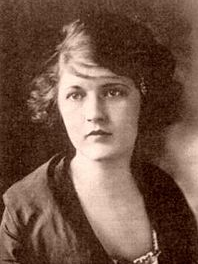
It is telling that few previews and news stories about the film have gone without mention of Fitzgerald's wife, Zelda Fitzgerald. He called her the the 'first American flapper' and used her as proof of his expertise on this new trend, which he was frequently quizzed about - instead of any actual flappers being asked about their lifestyle. Because what would they know?
Zelda Sayre was never going to be ordinary. She came from what is known as an old family in Alabama, her father a well respected Justice of the Supreme Court of Alabama. This allowed Zelda to flout convention with the flamboyance that later attracted Fitzgerald, she had a reputation, but it was the reputation of the daughter of a powerful man. Zelda could therefore get away with stunts such as swimming in a costume extremely close to her own skin tone - giving the intended impression that she swam naked.
When Zelda graduated from high school (a bright but unwilling student) her yearbook photo had the caption:
Why should all life be work, when we all can borrow.
Let's think only of today, and not worry about tomorrow.
In retrospect I might have suggested Zelda tried to live instead by these lines I have taken the liberty of making up:
Give them their orders marching
to boys with a centre parting.
| Zelda met F. Scott. Fitzgerald with his blonde centre parting, when he was stationed in Montgomery as an Army Lieutenant. The pair of them thought themselves special and so were immediately attracted to each other. They married once Fitzgerald's This Side of Paradise (featuring a character he modified to be based on Zelda) found a publisher and moved to New York where they quickly found the celebrity they craved through shocking everyone with drunken antics. | But without Zelda, surely Fitzgerald would not have been able to become such a sensation. |
When the couple and their daughter moved to Paris Zelda's unhappiness and dissatisfaction seems to have become clear to her. On meeting a French pilot she asked Fitzgerald for a divorce. In response he locked her in the house until she withdrew her request. In 1924 she took an overdose of sleeping pills and, once she had recovered, the couple never spoke of the incident again. Later, during an illness, Zelda took up painting.
When she was 27 Zelda decided to continue her long abandoned ballet training. It is said she became 'obsessed' with ballet. At 27 she was too old to truly begin a sparkling career in the world of dance, however she proved she had what the ballet world demands: complete dedication. She would train for 8 hours a day. In fact, contrary to what her husband thought of her balletic ambitions (a waste of time), the San Carlo Opera Ballet Company invited Zelda to join the company. She declined.
In 1930 Zelda's husband had her committed to a sanatorium. The pair then returned to America where Zelda was treated at the Phipps Clinic in Baltimore. It was during this time she wrote the book Save Me the Waltz. Taking her cue from Fitzgerald's style she plundered her marriage and life for inspiration – infuriating Fitzgerald who had planned to use the same episodes from their life together for his novel Tender is the Night. Her attempts to undo the damage done to her thwarted ambition and determination was diagnosed as schizophrenia. The desire to step out of her alcoholic husband's shadow using her own many talents deemed unhinged.
Zelda died in 1948 in a fire at the Highland Hospital. All that was left of her was a single, singed slipper.
Squeamish Kate


 RSS Feed
RSS Feed
